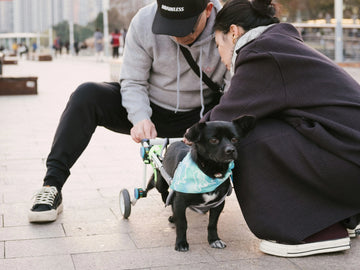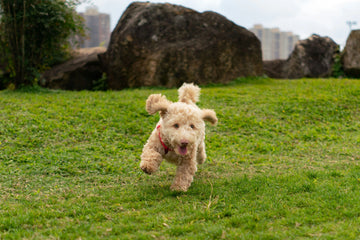A dog wheelchair isn’t a last resort; it’s a scientifically supported tool that helps dogs regain freedom and mobility.
You might notice a dog slipping occasionally or hesitating on the stairs. And one morning, it simply can’t stand up. You squat down, stroke its head—it still wags its tail, but it can no longer keep pace with your every step.
This isn’t the end. In many cases, the earlier you introduce a dog wheelchair, the more efficiently your dog can recover—and maintain its quality of life.

I. How a Dog Wheelchair Truly Aids Physical Recovery
A dog wheelchair isn’t just a hands-off transport—it’s a supportive device that helps dogs actively engage in rehabilitation by supporting posture, activating muscles, and enabling neurological pathways to rewire.
A 2023 study published in Frontiers in Veterinary Science found that 58% of paraplegic dogs regained voluntary walking ability through a combination of rehabilitation exercises and mobility devices. This is thanks to spinal walking mechanisms stimulated by supportive standing.

II. Mental and Physical Renewal: How a Dog Wheelchair Impacts Well-being
Movement isn’t just about muscle—it’s also about the soul. Dogs that can’t move freely often show signs of anxiety, low appetite, poor sleep, and reduced affection.
Once they regain some mobility—especially with a dog wheelchair—many become more alert, confident, and eager to engage again.
K9 Carts reports that over 70% of dogs using wheelchairs show improved appetite, better sleep, and increased social behavior within two weeks. Owners often say, “It’s like my dog came back to life.”
Mobility = quality of life.

III. The Earlier You Start with a Dog Wheelchair, the Better the Outcome
Too often, owners wait until their dog can no longer walk before considering a wheelchair—but that’s too late.
In cases of IVDD, degenerative myelopathy, or post-surgical recovery, introducing a dog wheelchair early can relieve joint strain, prevent further injury, and slow muscle loss.
In fact, the American Association of Rehabilitation Veterinarians (AARV) recommends adding mobility aids as soon as walking becomes unstable, rather than waiting for full paralysis.
IV. Choosing the Right Dog Wheelchair: Tailored Fit Matters
Not every dog wheelchair fits every dog. You must match it to your dog’s build, condition, and recovery goals:
-Dog Wheelchair for Back Legs
Best for dogs with hind-leg weakness, arthritis, or recovering from surgery. The front legs remain active while the wheelchair supports the back.

-Full Support Dog Wheelchair
Ideal for dogs with full-limb weakness, spinal conditions, or neurological issues. Provides full-body balance to reduce spinal stress.

-Dog Wheelchair for Small and Medium Dogs
Specifically engineered for dogs as light as 1.5 kg (around 3 lbs) up to 18 kg (40 lbs). Perfect for toy breeds—Chihuahuas, Pomeranians, Dachshunds—delivering proper support in a scaled-down frame.

Studies in canine biomechanics show that ill-fitting wheelchairs often distort posture, stress other joints, or impede natural motion. Always measure carefully and consult our team before ordering.
FAQ: Common Questions About Dog Wheelchairs
Q1: Can my dog go to the bathroom while wearing a dog wheelchair?
A: Yes. Most dog wheelchairs are designed with enough rear clearance, allowing dogs to urinate and defecate naturally.
Q2: My dog can still walk a bit—should I still use a wheelchair?
A: Absolutely. Wheelchairs support residual strength, helping dogs stay active while avoiding overexertion. They assist—not replace—natural movement.
Q3: Will my dog accept wearing a wheelchair? Is training difficult?
A: Most dogs adapt in 3–7 days with positive reinforcement. Start indoors for 5–10 minutes per session, gradually extending time and space.
Q4: How do I measure my dog for a wheelchair?
A: Please use a soft measuring tape to get:
-Body Length (from shoulder blades to base of the tail)
-Back Height (from the ground to the top of the back)
-Hip Width (across the widest part of the hips)
-Weight
-Breed

Opting for a dog wheelchair isn’t giving up—it’s choosing a different path forward.
They may not run like they used to—but they can still walk beside you, explore the yard, and chase falling leaves in the park.
In giving them the support they need, you give them a second life.
If you’ve ever wondered, “Is it too early for this?” — The answer is: now is the right time.
The above information is for reference only and should not replace professional veterinary advice.





